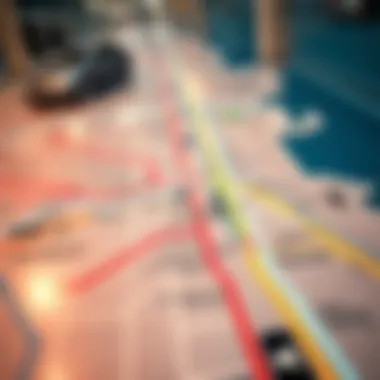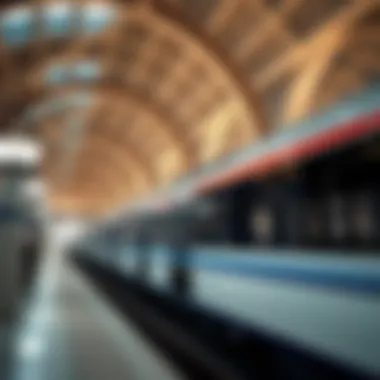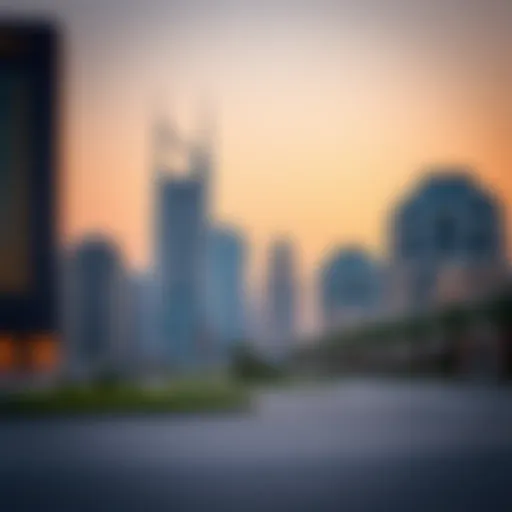Exploring the Dubai Metro: Its Role in Real Estate


Intro
In the bustling metropolis of Dubai, where innovation meets tradition, the Dubai Metro serves as a lifeline connecting various districts within the city. Installed with cutting-edge technology, this robust transit system not only moves people efficiently but also shapes the urban landscape and its real estate market. The metro has become an integral part of daily life, offering easy access to key locations—from shopping centers to business districts.
The interplay between the metro's routes and the property market is significant, influencing property values and residential choices. The proximity of a property to a metro station can make or break its appeal. For investors and homebuyers alike, understanding this relationship is vital. From established neighborhoods to emerging hotspots, knowing where to place your bets can yield lucrative returns.
As we delve into this comprehensive guide, we will uncover the various routes, the stations that serve them, accessibility features, and the impact on real estate trends. We'll also peek into future developments planned for the metro and discuss what that could mean for investors and residents. This exploration will help clarify the essential role public transport plays in shaping opportunities and lifestyle choices in Dubai.
Keywords to Consider:
- Dubai Metro
- Urbanization
- Real Estate Market
- Property Investment
- Accessibility and Public Transport
Overview of the Dubai Metro
The Dubai Metro has become an essential cog in the wheel of urban transport, providing a crucial foundation for the bustling city's infrastructure. This thoroughfare is not merely about moving people; it is a lifeline that interweaves various sectors of society, significantly contributing to the dynamism of the area's real estate market. Historically, its advent changed the game for commuters and investors alike, reshaping how residents interact with the broader cityscape and influencing property investments in numerous ways.
History and Development
The story of the Dubai Metro began in the early 2000s. In a bid to tackle rapid urbanization and an escalating population, city planners embarked on a journey to establish a world-class public transportation system. The project was conceived with the aspirations of supporting high-density urban areas while also addressing the city’s escalating traffic woes. Ground was broken in 2006, and the first line, the Red Line, was finally operational by 2009. Today, the Metro's growth represents not just a functional transport line, but a statement of Dubai’s ambition and forward-thinking.
As the network expanded, so did the vision, with additional lines and stations strategically planned to facilitate accessibility. The 2010 inauguration of the Green Line is testament to how proactive planning can keep pace with a swiftly evolving metropolis. The Metro's development reflects Dubai's dedication to sustainable urban living while stimulating various sectors, including real estate, hospitality, and commerce.
Current Infrastructure
Currently, the Dubai Metro boasts two primary lines—the Red and the Green—extending across approximately 90 kilometers, with a plethora of stations strategically placed at key points throughout the city. Elevated and underground tracks blend seamlessly into the urban fabric, making it a striking feature of Dubai’s skyline. The vast network connects essential areas including business hubs, residential districts, and leisure spots.
Notably, the trains are driverless and run with clockwork precision—frequency can be as short as two minutes during peak hours. This efficiency not only ensures ease for daily commuters but also instills confidence in investors seeking to harness the potential that comes with proximity to transit links. The infrastructure continues to develop, with plans for future expansions to reach new areas, further enhancing connectivity and accessibility across the city.
Key Features
One of the hallmark attributes of the Dubai Metro is its commitment to passenger comfort and convenience. Features include spacious trains equipped with free Wi-Fi, mobile charging stations, and well-maintained station facilities. The stations are designed with safety and user accessibility in mind, featuring ramps, elevators, and signage in multiple languages.
Additionally, the Metro employs a color-coded system that simplifies navigation for both locals and tourists. This system is integrated with various transport modes such as buses and taxis, ensuring a seamless transit experience.
Fact: The Dubai Metro is recognized as one of the longest automated metro networks in the world, reflecting Dubai’s commitment to innovation in urban mobility.
Investors and industry stakeholders should observe that the Metro is more than a mode of transport; it represents a connective tissue that binds various neighborhoods, enhancing their desirability. Proximity to Metro stations can play a pivotal role in shaping property values, making the understanding of this infrastructure vital for anyone involved in Dubai's real estate market. The Metro’s evolution and investment potential become clearer as one examines its history, infrastructure, and key features.
Importance of the Metro in Urban Mobility
The role of the Dubai Metro in urban mobility cannot be overstated; it serves as the backbone of the city’s public transport system. With the rapid rise in population and the accompanying challenges of urban congestion, the metro has emerged as a vital solution. By offering a reliable and efficient means of transportation, it enhances the quality of life for residents and supports the city’s ambitious growth objectives.
Connecting Key Districts
One of the standout features of the Dubai Metro is its ability to connect diverse districts seamlessly. Unlike many cities where public transit might take the long route around, the metro's layout is designed to provide direct access to important landmarks. Consider how the Red Line stretches from Rashidiya to UAE Exchange, covering financial hubs, residential communities, and leisure areas along the way. That means a commuter can hop on at the Mall of the Emirates and disembark near Dubai Marina, experiencing the city's vibrancy without the hassle of traffic. This connectivity fosters not only personal convenience but also economic activity by enabling better access to businesses.
Benefits of Connecting Districts
- Ease of Access: With stations strategically located near key areas, residents save significant time.
- Economic Growth: Businesses benefit from increased foot traffic as more people can reach them easily.
- Community Building: Individuals from different walks of life can converge at public spaces, promoting social connectivity.
Integration with Other Transport Modes
The effectiveness of the metro goes beyond the trains themselves; it’s all about integration. Dubai has taken steps to ensure that the metro works in tandem with other transport options, like taxis, buses, and even ride-sharing services. For instance, most metro stations have designated areas for taxis or are located near bus stops, allowing commuters to switch modes with ease.
This interconnectedness prevents gaps in service and facilitates a smooth transit experience.
Such integration helps not only in enhancing operational efficiency but also in encouraging public transport use, further relieving the burden of road congestion. For those who travel frequently, the Nol card allows for easy transitions between various transport modes without requiring separate payment tickets.
Impact on Traffic Congestion


One of the most pressing issues in any major city is traffic congestion, and Dubai is no exception. The metro has proven to be a game-changer in mitigating these challenges. By providing an alternative to car travel, particularly during peak hours, the metro significantly reduces the number of vehicles on the roads.
As people increasingly opt for the metro, the city’s road infrastructure benefits by experiencing less strain, leading to improved travel times for those who must drive. Data suggests that on days when metro ridership spikes, there is a notable dip in congestion levels in surrounding areas. This synergy among various transport modes paves the way for a more livable urban environment.
In summation, the importance of the Dubai Metro in urban mobility encompasses its ability to connect vital districts, interface effectively with other transport options, and substantially curb traffic woes. All these factors contribute to an economically vibrant metropolis, making the metro much more than just a transport system—it's a crucial element in the fabric of Dubai's urban identity.
Understanding the Metro Map
The Dubai Metro map plays a crucial role in enhancing urban connectivity within the bustling city. Understanding the intricacies of this map is essential for various stakeholders, ranging from investors to daily commuters. An efficient metro system can be a game changer in urban planning and property development, making knowledge about the routes and stations indispensable.
Overview of Lines and Stations
Dubai Metro is not just a mode of transport; it’s a lifeline for many. The map outlines multiple lines, each connecting vital districts of the city. The Red and Green lines serve as the backbone of the metro network, with the Red line slicing through the heart of the urban landscape, while the Green line meanders through residential and commercial hotspots, providing choices for expatriates, locals, and tourists alike.
Key Lines:
- Red Line: Stretching approximately 52 kilometers, it connects Dubai International Airport to the bustling areas like Burj Khalifa and Dubai Marina.
- Green Line: This line runs for about 22.5 kilometers, touching the areas known for their vibrant expat communities.
Each station is carefully located to ensure maximum accessibility. For instance, the Burj Khalifa station is positioned to cater to both tourists and residents, making it a prime area for potential property investments. This strategic placement underlines the importance of understanding the map, not just for commuting but also for real estate considerations.
Color-Coded System Explained
Color coding on the metro map is an intuitive feature that simplifies navigation. Each line is assigned a distinct color. This allows commuters to easily identify their routes at a glance. For example, passengers can spot the Red Line, represented by a deep red hue, and the Green Line, with its vibrant green show, without even needing to read the station names.
Benefits of the Color System:
- Quick Navigation: Passengers can quickly understand which line to take, minimizing travel planning time.
- Reduced Confusion: For those not familiar with the city or language, colors serve as a universal guide.
Understanding this coding system can greatly enhance the experience of users, making it easier for first-time riders to explore the city safely and efficiently.
Navigating the Map Efficiently
Efficiency in navigating the metro map is fundamental for a user-friendly experience. Besides grasping the basic layout, users can benefit from several strategies that can streamline their travels.
- Plan Ahead: Familiarizing oneself with the map before embarking on a journey can save time.
- Use the Metro App: Apps often include live updates and route suggestions, helping passengers avoid crowded times.
- Interchange Stations: Knowing key interchange stations can facilitate smoother transitions between lines, cutting down travel time significantly.
Commuters should remain aware of peak times and consider traveling during off-peak hours to ensure they have a more comfortable experience. The right navigation approach not only enhances the daily commute but also helps investors gauge the accessibility of potential property acquisitions in relation to metro stations.
Understanding the Dubai Metro map is not merely about commuting; it’s about unlocking the city’s potential, both professionally and personally.
As the metro continues to evolve, keeping an eye on changes in the map will benefit residents and investors alike. This deeper comprehension fosters not just convenience but also informed decision-making in real estate investments.
Real Estate Implications of the Metro
The connection made by the Dubai Metro is not just about providing a mode of transport; it significantly alters the real estate landscape of the city. As urban residential preferences evolve, the proximity to metro stations becomes a prime factor for homebuyers and renters, directly correlating to property values and desirability. Understanding how the metro influences real estate offers crucial insights for investors, developers, and homeowners alike. In this section, we will explore the significant facets of how metro access shapes property markets and what this means for various stakeholders.
Influence on Property Values
The proximity of properties to metro stations often translates into increased property values. A study might reveal that homes located within a short walking distance to a metro station could command prices that are significantly higher compared to those further away. For example, a two-bedroom apartment in Al Quoz, near an upcoming metro extension, might see its value appreciate by as much as 20% just because of improved access to this transport link.
Moreover, the supply and demand equation in real estate is heavily influenced by metro connectivity. When new metro lines are announced, neighborhoods that once seemed off the beaten path become more appealing. People tend to gravitate towards properties they perceive will have a solid resale value in the future, making such areas increasingly sought after.
"In urban settings, accessibility is a game changer. The easier you can get around, the hotter the property potential."
Attractiveness of Neighborhoods
It's not just about rising values—neighborhood beauty or appeal comes into play as well. With metro connections, certain areas become vibrant hubs of activity, transforming from quiet localities into buzzing districts. Areas like Dubai Marina, with its stunning waterfront views and rich lifestyle, become all the more enticing with the addition of well-placed metro stations. Residents can find themselves living in a bustling area where leisure, work, and culture intersect seamlessly.
Critically, this 'attractiveness' also often leads to improved amenities in these neighborhoods. Developers and city planners often respond to the increased foot traffic by enhancing services, parks, and even commercial spaces. Investors eye such conditions closely, as they indicate a growing market where property is not only valued for its location but also for its community integration.


Investment Opportunities Near Stations
For investors, the Dubai Metro unlocks a treasure trove of opportunities. Properties situated just a stone’s throw from metro stations often represent a safer bet in terms of financial appreciation. New developments are springing up around key metro stations such as Burj Khalifa, where various residential and commercial projects are in the pipeline. Investors can particularly look into mixed-use developments which combine living, shopping, and leisure within proximity to excellent transit options.
Additionally, buying into these neighborhoods early can yield substantial profits as the area develops. A savvy investor might purchase a unit in one of these burgeoning neighborhoods to benefit from favorable rental yields as demand soars. The operational metro not only provides ease of movement but often attracts businesses that contribute to a more robust local economy, thus enhancing profitability.
Case Studies of Popular Areas
Examining the interplay of the Dubai Metro with real estate calls for a closer look at popular areas where the metro has made its mark. This insight not only illuminates the impact on property values but also illustrates how accessibility shapes residential preferences and investment strategies. Focusing on areas like Dubai Marina, Jumeirah Lakes Towers, and Downtown Dubai, we uncover unique narratives that highlight the crucial link between public transport and real estate prospects.
Dubai Marina
Nestled along the coastline, Dubai Marina epitomizes the blend of luxury and modern living. With the metro station serving its community, this area benefits from enhanced connectivity to the rest of the city. The stunning waterfront views appeal to both residents and investors alike.
Key Highlights:
- Accessibility: With the Dubai Marina Metro Station, residents enjoy a seamless journey into the heart of the city and beyond.
- Vibrant Atmosphere: Plenty of restaurants, cafes, and entertainment options draw both locals and tourists, boosting property demand.
- Rising Property Values: The metro's presence has been a driving force behind increasing real estate prices, making it a coveted destination for investors.
This area is more than a place to live; it is a lifestyle. The metro has carved pathways through the outskirts of the Marina, offering ease of access that keeps the interest of potential renters and buyers.
Jumeirah Lakes Towers
Jumeirah Lakes Towers, often abbreviated as JLT, is an enclave brimming with high-rise buildings, parks, and man-made lakes. The JLT Metro Station serves as a pivotal link, providing residents with swift access to the commercial hubs and leisure areas around the city.
Key Highlights:
- Diverse Property Options: From luxury apartments to office spaces, JLT caters to a wide range of needs and budgets due in part to its accessibility via the metro.
- Community Amenities: The area's parks and lakes make it attractive for families, thus encouraging demand for residential units.
- Investment Potential: The ongoing development and accessibility promise lucrative returns, attracting both local and foreign investors.
JLT's strategic positioning along the metro line capitalizes on urban mobility trends, driving real estate demand higher.
Downtown Dubai
Downtown Dubai stands as the crown jewel, showcasing some of the most iconic landmarks, including the Burj Khalifa and Dubai Mall. The metro station here facilitates easy access for both residents and visitors, making it a prime investment locale.
Key Highlights:
- High Foot Traffic: The proximity to tourist spots leads to high demand for rental properties, amplifying returns for property owners.
- Luxury Living: The area offers upscale apartments and hotels that appeal to affluent buyers, prompting increases in average property prices.
- Quality of Life: Access to lush green spaces, high-end shopping, and fine dining enhances livability, attracting a well-heeled demographic.
With its metro connection, Downtown Dubai continuously thrives as a hub for both short-term and long-term growth, reflecting a dynamic urban landscape connected by efficient transport.
The presence of a metro station often enhances the desirability of a neighborhood, intensifying its market value and appeal.
In summary, each of these areas—Dubai Marina, Jumeirah Lakes Towers, and Downtown Dubai—demonstrate how the metro influences real estate dynamics, driving up demand and reshaping urban living. Investors should keep these districts on their radar as they continue to evolve with the Dubai Metro's expansion.
Future Developments Related to the Metro
The Dubai Metro is more than just a transit system; it’s a vital component of the city’s growth strategy. Understanding its future developments is crucial for those in real estate and urban planning. The expansion of this network, along with technological upgrades and sustainability efforts, plays a significant role in how the metro influences property values and residential choices.
Expansion Plans
The Dubai Metro expansion plans are ambitious. Authorities aim to extend the current lines, introduce new routes, and increase station accessibility across the city. The most noteworthy project is the extension of the Red Line and the introduction of new Green Line stations.
These enhancements promise to bring numerous benefits:
- Increased Accessibility: Areas that were once hard to reach will now have direct access to the metro, making them more attractive for both homebuyers and investors.
- Transit-Oriented Developments: Developers are keen to design properties that cater to commuters. Being close to a metro station increases property desirability, thereby influencing prices positively.
- Projected Growth Zones: New lines are often planned to connect with high-demand areas, such as upcoming commercial hubs and residential neighborhoods.
In essence, better connectivity translates into economic viability, making it a game-changer for real estate agents and prospective homeowners alike.
Technological Advancements


With a city like Dubai, it’s essential to stay on the cutting edge of technology. The metro is set to integrate modern technologies that enhance efficiency and user experience. This includes:
- Smart Ticketing: The shift to digital ticketing systems aims to simplify travel and reduce wait times. Commuters can look forward to mobile applications that allow for seamless fare payments and real-time updates.
- Monitoring Systems: Advanced train monitoring systems will reduce delays and improve service reliability. This can significantly impact commuter satisfaction and, in turn, influence property appeal.
- Energy Management: Future plans include implementing energy-efficient systems within the metro which will contribute to lower operational costs, making it a sustainable choice for urban transport.
These advancements make the metro system more appealing not just for transit users but also for potential real estate investors looking for low-risk opportunities in growing urban areas.
Sustainability Initiatives
Sustainability has become a focal point in urban development across the globe. The Dubai Metro is committed to reducing its carbon footprint and enhancing eco-friendly practices.
Key initiatives include:
- Carbon Neutral Goals: The metro aims to achieve carbon neutrality by 2050, engaging in several programs like using solar energy and investing in energy-efficient trains.
- Green Certifications: Stations and infrastructure are being designed with LEED (Leadership in Energy and Environmental Design) standards in mind, which can boost the appeal of nearby properties for environmentally-conscious buyers.
- Promotion of Public Transport: By increasing the metro’s capacity and efficiency, the initiative encourages more residents to rely on public transport, thus reducing traffic congestion and pollution.
"A well-planned metro system is essential for a sustainable urban future, intertwining both environmental harmony and economic growth."
As the metro evolves, these sustainability measures align with the growing trend of mindful investing, appealing to a demographic that favors green living.
In summary, the future developments of the Dubai Metro promise not just enhanced connectivity but also drive economic growth and sustainability. For investors and homeowners alike, this presents unique opportunities in a rapidly evolving real estate landscape.
Navigating Challenges and Benefits
The development of the Dubai Metro has not come without its fair share of hurdles. Understanding these challenges, however, is crucial for stakeholders who are interested in how the metro system influences urban life and real estate dynamics. The myriad benefits that result from a well-integrated public transport system often serve to outweigh these challenges. In this section, we delve into three major elements: accessibility issues, economic considerations, and public perception of the metro services.
Accessibility Issues
Access to the metro is essential for maximizing its effectiveness. Although the Metro system connects many major districts, some areas remain somewhat isolated. For instance, consider the low ridership in certain neighborhoods bordering the outskirts of the metro infrastructure. People living in these areas may find it cumbersome to reach the nearest metro station, leading to an unnecessary reliance on personal vehicles. To compound matters, the lack of proper pedestrian walkways and safe bicycle lanes can also deter people from using the metro as their primary mode of transport.
The design of metro station entrances must prioritize ease of access for individuals with mobility challenges. Some stations might not be fully equipped with elevators or adequate signage, making it difficult for everyone, especially the elderly or those with disabilities, to navigate through the metro system effectively. For investors and urban planners, addressing these accessibility concerns is a pivotal step in enhancing the attractiveness of surrounding real estate.
Economic Considerations
Investing in infrastructure yields significant economic benefits, and the Dubai Metro is no exception. The presence of the metro system can substantially regulate property values. Areas surrounded by or adjacent to metro stations generally see an increase in property prices due to enhanced accessibility. However, these benefits can also introduce market inconsistencies. Properties that were once affordable might become too expensive for average families, forcing them to move further away from the central business districts until they find cheaper housing options.
The metro also saves commuters substantial sums on travel costs over time compared to driving. The Dubai Metro is a more budget-friendly alternative to owning a car, helping families allocate funds towards investments in property or other areas of their lives. Greater utilization of public transport correlates with lower traffic congestion, thus reflecting positively on the local economy.
Public Perception and Usage
Public perception plays a vital role in the overall success of the metro. Studies have shown that positive sentiment towards public transport can significantly increase ridership. However, the initial public perception of the metro was mixed; while some praised it as a transformative step for the city, others found it lacking in areas such as cleanliness and reliability.
“Public transport systems are only as good as the perception of their users.”
This sentiment often rings true, especially in a city where rapid change is the norm. Transit systems thrive on community goodwill. When folks feel their needs are being met and that they can rely on these transportation options, ridership rises.
For real estate stakeholders, understanding the perception of the metro directly impacts housing demand. Familiarizing oneself with residents' attitudes can lead to more informed decisions regarding property development. A more favorable view of the metro translates to higher property desirability, thus benefiting investors in the long run.
Culmination: The Interplay Between Metro and Real Estate
The relationship between the Dubai Metro and the real estate landscape can’t be overstated. This connection serves not just as a means of transportation but also as a pivotal influence on urban development and property value fluctuations. As cities expand, the essentiality of efficient public transport systems like the metro becomes more pronounced, shaping the preferences of homebuyers and investors alike. The metro's accessibility can transform previously overlooked areas into vibrant neighborhoods, driving demand and ultimately altering the real estate narrative.
Summary of Insights
To encapsulate the key findings of this article:
- Connectivity Boost: The metro significantly enhances the connectivity of various districts, offering residents convenient access to employment and entertainment hubs.
- Increased Property Values: Areas in close proximity to metro stations often witness an uptick in property demand, resulting in higher property prices. This trend is particularly noticeable in neighborhoods such as Dubai Marina and Downtown Dubai.
- Investment Appeal: The metro's expansion plays a crucial role in highlighting underrated areas as potential hotspots for real estate investment, paving the way for both residential and commercial opportunities.
An illustrative example is Jumeirah Lakes Towers; its proximity to the metro has elevated its desirability among expatriates, leading to a dramatic increase in rental prices in recent years. Therefore, understanding the dynamics of the metro system is fundamental for anyone looking to navigate the vibrant yet sometimes volatile Dubai real estate market.
Future Outlook for Investors
Looking ahead, the interplay between the Dubai Metro and real estate is likely to become even more intricate. As the metro expands further into emerging districts, potential investors should keep an eye on upcoming stations and planned extensions. The increasing reliance on public transport can yield lucrative returns for those investing in properties near these future developments.
Moreover, the trend towards sustainable urban living is gaining momentum. Investors who prioritize properties aligned with this new direction, particularly those near metro lines, may find themselves ahead of the curve. After all, many city dwellers are shifting their focus towards convenience and environmental impact when considering their housing options.
"Understanding the correlation between public transit and property values is key for anyone looking to make informed investment decisions in Dubai's dynamic market."
For further reading on the Dubai Metro's evolution and its implications on urban living, you can visit Wikipedia and Britannica.
An intelligent investment strategy hinges on a commitment to understanding these developments as they unfold.







